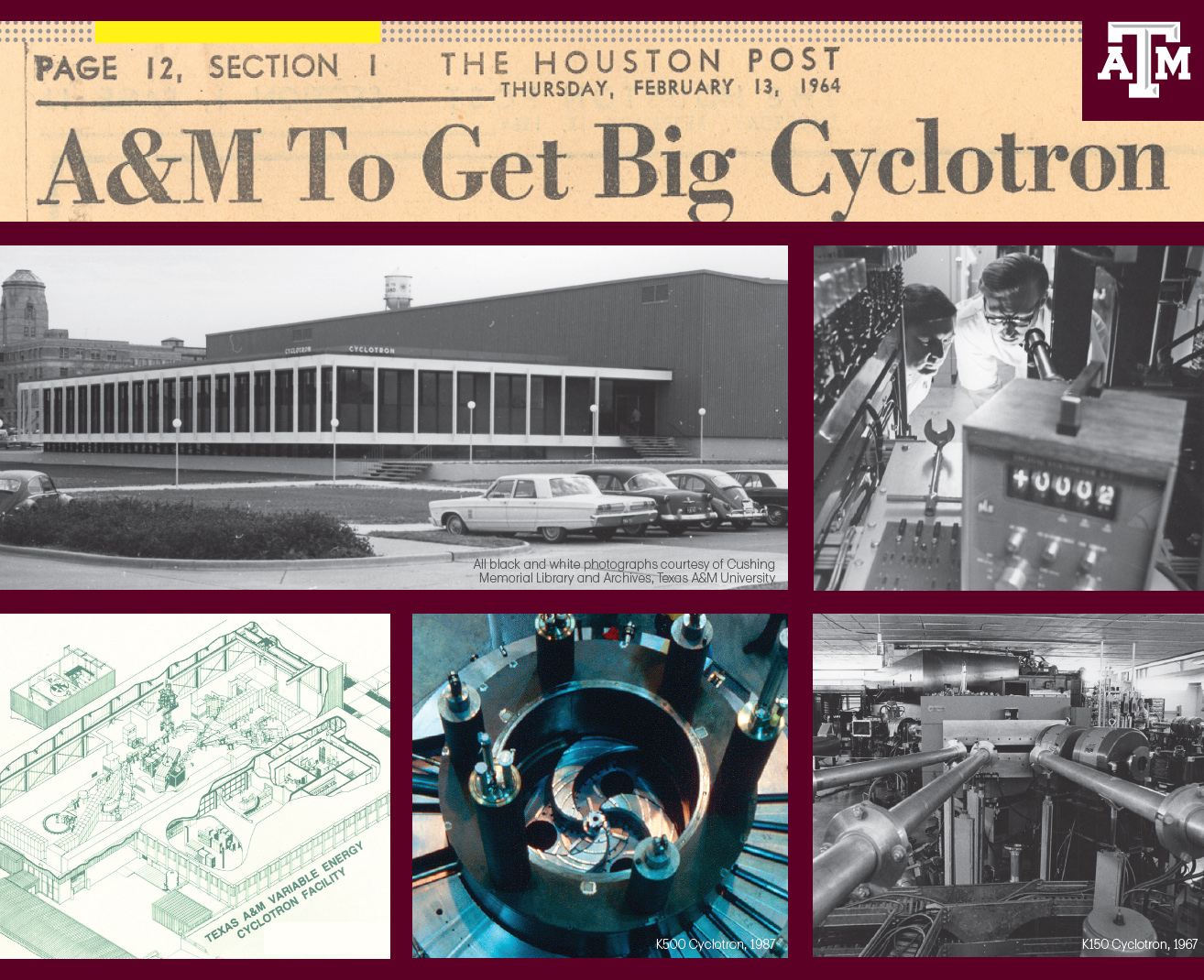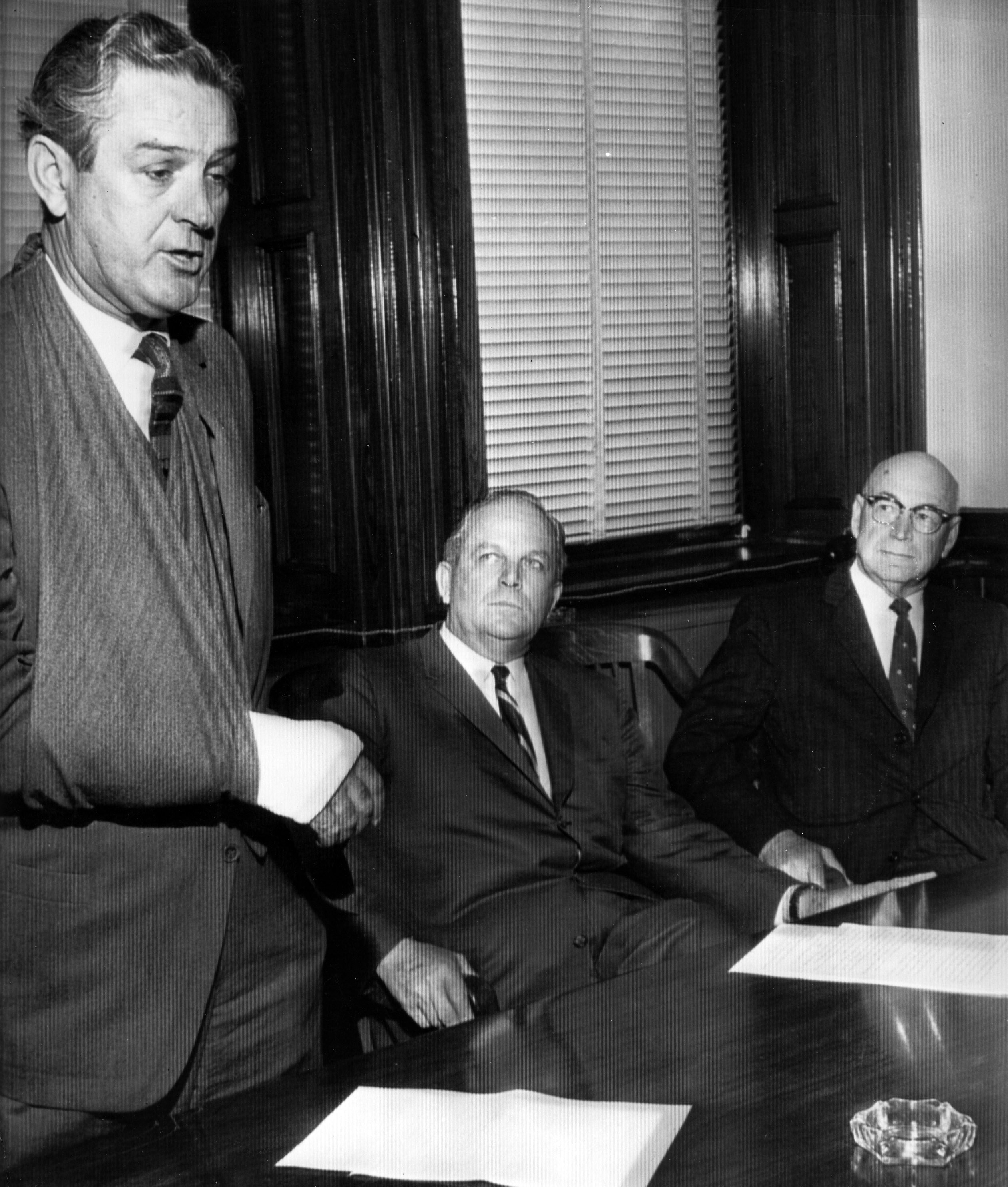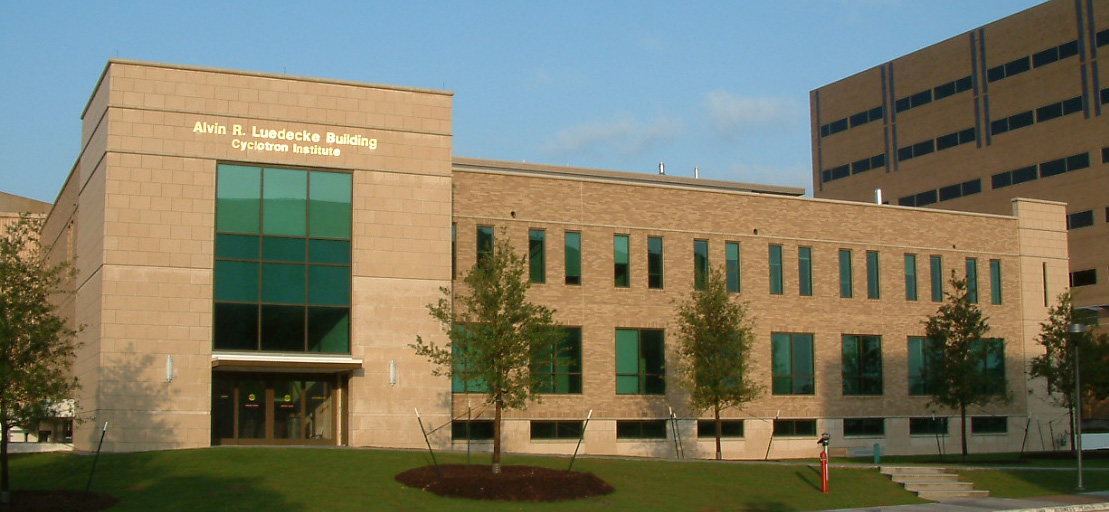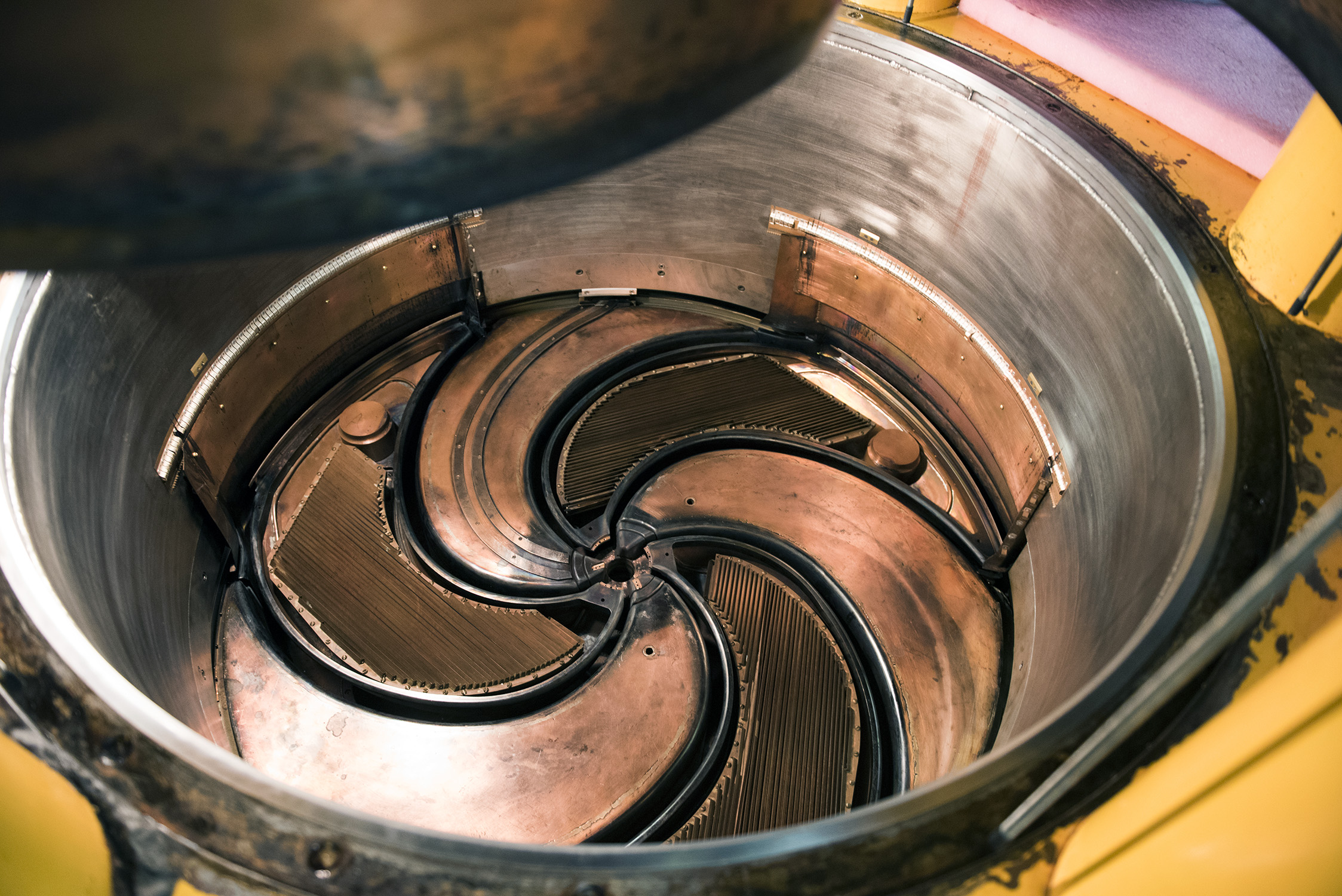
Sixty years ago this month, nuclear science history was made in Aggieland.
In 1964, Texas Governor John B. Connally personally visited the Texas A&M University campus to deliver the good news to then-Texas A&M President James Earl Rudder ’32 that a $6 million “atom smasher” would be built at Texas A&M, thanks to a unique public-private partnership involving the Atomic Energy Commission, the state of Texas and the Welch Foundation.
“This is one of the most significant announcements to be made this year and perhaps for some time,” Connally told The Houston Post at the time regarding the new cyclotron, the fourth to be located on a university campus and the largest in the South. “It is the biggest thing of its kind east of Berkeley, Calif.”
On December 4, 1967, Nobel Prize winners Glenn T. Seaborg and Willard F. Libby helped dedicate the Texas A&M Cyclotron Institute — three days after it had achieved its first external cyclotron-accelerated particle beam, thanks to a 400-ton, 2,000-kilowatt magnet whose power was equivalent to one-fifth of the output of the Texas A&M Power Plant. Twenty years later, that K150 cyclotron was joined by a K500, currently one of the world’s five largest superconducting cyclotrons.
Core Value
The Cyclotron Institute, a U.S. Department of Energy University Facility and one of five DOE-designated Centers of Excellence, is directed by University Distinguished Professor and Regents Professor of Chemistry Dr. Sherry J. Yennello. It is jointly supported by the DOE and the state of Texas as a major technical and educational resource for the state, nation and world dedicated to discovery science, workforce development and related applications to society. Internationally recognized for its research, the institute provides the primary infrastructure support for Texas A&M’s graduate programs in nuclear science. In addition to conducting basic research and educating students in accelerator-based science and technology, the institute provides technical capabilities for a wide variety of applications in space science, materials science, analytical procedures and nuclear medicine.

At the time of its founding, the variable energy cyclotron was expected to deliver the kind of basic research that Connally had noted was in short supply and was lauded by Rudder as “a real breakthrough into excellence.”
“Texas A&M has accepted Governor Connally’s challenge to keep the state’s brainpower at home,” Rudder said. “A&M’s Cyclotron Institute will attract top scientists and should double our doctoral studies in physics and chemistry.”
Financing for the fledgling Cyclotron Institute came from private, state and federal sources, a tradition that continues to this day. Initial building costs and associated equipment requirements were covered by the Houston-based Welch Foundation and Texas A&M’s state legislature-appropriated funds. The Atomic Energy Commission, the predecessor to the DOE, provided $3.25 million for the construction of the cyclotron itself, which was patterned after the 88-inch instrument and facility previously constructed at Berkeley.
In The Cards
Both the Texas A&M instrument and faculty were built equal in size to Berkeley’s. At the time, there were only two other cyclotrons under construction nationwide — Michigan State University and the University of Colorado — and both were smaller.
“We were an exact replica of them, from the 88-inch cyclotron — our original K150 — to the overall facility,” said research professor Dr. Yiu Wing Lui, a member of Yennello’s research group. “They had a much better view, though.”
Lui took his own Texas-sized leap of faith back in 1978, traveling to College Station from England after talking to then-Cyclotron Institute Director Dr. Dave Youngblood at a 1977 conference held at the University of Birmingham, where Youngblood mentioned he was hiring and left Lui with his business card.
“Later on, I decided to check things out, really intending to go to Berkeley,” Lui said. “Things fell through for one reason or another, so my wife and I boarded the train to College Station. When we got off at the station, no one even knew what or where the Cyclotron was! I originally intended to stay only a year or so, but I never found time to leave.”

Then And Now
What began in the 1960s in Aggieland with a staff of 14 teachers plus graduate assistants and an annual operating budget of approximately $1 million now accounts for a world-renowned nuclear science program involving more than 100 affiliated members — scientists, engineers, technicians, support staff, and graduate and undergraduate students. Institute scientists publish nearly 100 papers per year in leading scientific journals, and the institute serves as a technical support base for collaborative research programs at other major national and international accelerator facilities while also hosting scientists from numerous laboratories across the nation and world.
The DOE funding that has been continuous ever since sports a current grant number from the Office of Nuclear Physics dating back to 1993 — the same year Yennello came to Texas A&M — most recently was renewed in May 2023 for an additional three years at $13 million.
In addition, the Cyclotron Institute is home to a DOE/National Nuclear Security Administration Center of Excellence program, CENTAUR, a seven-institution collaboration whose mission is to provide the research experience necessary to develop next-generation leaders in stewardship science in the area of low-energy nuclear science to support workforce-development and research-related needs relevant to the nation’s stockpile stewardship goals. The institute also leads a $2 million, 15-institution, DOE-funded isotope traineeship effort, the Horizon-broadening Isotope Production Pipeline Opportunities (HIPPO) program. And last fall, it served as one of 21 host sites nationwide — the only one in Texas — for the rollout of the 2023 Long Range Plan for Nuclear Science that provides a roadmap for advancing the nation’s nuclear science research programs during the next decade.
Tried And Tested
Beyond primary funding from the DOE and National Science Foundation that totals $9.8 million annually, the Cyclotron Institute brings in significant revenue from external research grants. In addition, testing by companies and agencies (including Boeing, Lockheed-Martin, NASA, the Jet Propulsion Laboratory and the U.S. Navy Laboratories) that rent time on the cyclotron for their own research projects nets more than $5 million annually, generating a total exceeding $15 million in overall external funding each year.

Through the years, institute facilities have been used for cancer therapy, radiation dosimetry, studies of plant physiology, precise analytical determinations, development of mass-spectrometric techniques, studies of “high T” superconductors, evaluation of nuclear waste transmutation techniques and simulation of cosmic-radiation-induced effects on microelectronic circuits. The resulting breakthroughs have been myriad, including many products such as OnStar, for which the Cyclotron Institute did all the testing back in the 1990s, that now are household names.
While the discovery science program has been ongoing for more than 55 years, the institute took on a new distinct competency in 1995 — testing electronics for the effects of radiation. In the course of the past three decades, this program has grown to encompass more than 4,000 hours of dedicated beam time per year, establishing Texas A&M as the premier location in not only the U.S. but also the world at which to do testing of heavy ion interactions with electronics, an important safeguard for both commercial and military satellites as well as space missions. Each year, more than 500 users come to the institute for these critical studies, perhaps none more memorable than SpaceX and the pivotal testing for nearly 100 electronic components of its Crew Dragon capsule that made history in 2020 as the first crewed spacecraft to lift off from American soil since 2011.
Additionally, in the last few years, the institute has initiated a program to produce Astatine-211, an alpha-emitting nucleus that is a promising isotope for targeted alpha therapy for cancer treatment.
The state’s and nation’s original investment back in 1964 was in support of discovery science — a bold move that Yennello says has paid off in spades in terms of both basic and applied research. The decades since have borne witness to many unforeseen benefits, from medical isotopes to chip testing. In 2022, the U.S. Department of Defense awarded an $11 million grant to the Cyclotron Institute for facility improvements to enhance the institute’s capacity in the latter category — improvements that Yennello says will benefit both the applied and fundamental work underway within the institute.
“The Cyclotron Institute represents the best of government, academia, industry and philanthropy at work for the greater good,” Yennello said. “It is this synergy of fundamental science, applications and workforce development through education that is really powerful across all sectors. We are honored and proud to celebrate what we see as a collective success for our state, nation and world that we’re fortunate to have right here in our backyard.”
Did You Know?
Two publications featuring Texas A&M Cyclotron Institute-exclusive teams and related studies are among the seven selected thus far in 2024 as "Editors' Suggestions" by the American Physical Society journal Physical Review C. This special designation is reserved for articles that the journal's editorial board considers most important.
The first paper, led by Dr. Ralf Rapp, provides a theoretical foundation for an understanding of the recently observed enhancement to recombination processes of heavy quarks in quark-gluon plasma, or the state of matter that existed during the first few seconds after the Big Bang. The second paper, led by Dr. Grigory Rogachev, provides accurate experimental data on the probability of formation of carbon-12 in a stellar environment while also eliminating a controversy that emerged due to recent, apparently incorrect measurements from an Australian group that claimed that carbon-12 is forming with a probability enhanced by 50% than what previously was assumed.
